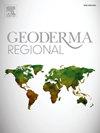An evaluation framework for identifying saline croplands for improvement: A case study of Songnen Plain
IF 3.3
2区 农林科学
Q2 SOIL SCIENCE
引用次数: 0
Abstract
Land salinisation in the Songnen Plain is a serious constraint to agricultural development. Assessing and identifying saline land as having advantages for improvement is of great significance for improving the efficiency of saline croplands improvement. Taking the western Songnen Plain as the study area, an evaluation framework for identifying saline-alkali croplands for improvement was proposed. Compared with traditional research models that evaluate the degree of saline-alkali land suitable for farming, the purpose of this study is to identify land that is easier to improve and has more or more value for farming. On the basis of evaluating the suitability of saline-alkali land using the Analytic Hierarchy Process-Geographic Information System (AHP-GIS) model, this framework incorporates the degree of soil salinisation, quantified by electrical conductivity and exchangeable sodium percentage, and hydrological connectivity, calculated based on terrain factors and vegetation cover., constructs a saline-alkali land improvement index, and divides suitable improvement areas at different levels. The results indicate that the northern part of the study area exhibits low cropland suitability value, primarily due to higher pH values, unfavorable topography, and lower temperatures. Extreme salinity area are concentrated in the central part of the study area, mainly due to elevated soil conductivity and exchangeable sodium percentages. Areas with high hydrological connectivity value are distributed in the northern, southern, and eastern parts, owing to the presence of numerous lakes and dense vegetation cover. Using the Suitable Improvement Index (SII), 39.42 % of the croplands were identified as suitable for improvement. Among these, low-value, moderate-value, and high-value accounted for approximately 5.43 %, 33.36 %, and 61.21 % of SII subareas. The low SII values are found in Qianan and Tongyu in the southern and central parts of the study area, while high SII values are distributed in Tongyu, Daan, and Taobei in the central part of the study area. The evaluation framework of this study identifies saline-alkali croplands that is more suitable for improvement, providing valuable insights into the restoration of saline-alkali croplands in Northeast China. We provides valuable insights into saline-alkali land restoration from a management and strategic perspective.
盐碱地改良评价框架——以松嫩平原为例
松嫩平原土地盐碱化严重制约了农业的发展。评价和识别盐碱地改良优势对提高盐碱地改良效率具有重要意义。以松嫩平原西部为研究区,提出了盐碱地整治评价框架。与传统评价盐碱地适宜耕作程度的研究模型相比,本研究的目的是识别出更容易改良、更有或更有耕作价值的土地。在使用层次分析法-地理信息系统(AHP-GIS)模型评估盐碱地适宜性的基础上,该框架结合了土壤盐碱化程度(通过电导率和交换钠百分比量化)和水文连通性(基于地形因素和植被覆盖计算)。,构建盐碱地整治指标,划分不同层次的适宜整治区域。结果表明:研究区北部土壤pH值较高,地形条件不利,气温较低,土壤适宜度较低;极端盐度区主要集中在研究区的中部,主要是由于土壤电导率和交换性钠含量升高所致。水文连通性高的地区分布在北部、南部和东部,湖泊众多,植被覆盖茂密。利用适宜改善指数(SII), 39.42%的耕地被确定为适宜改善的耕地。其中,低值、中值和高值分别占SII分区的5.43%、33.36%和61.21%。研究区南部和中部潜安和通玉的SII值较低,中部通玉、大安和桃北的SII值较高。本研究的评价框架确定了更适合改良的盐碱地,为东北盐碱地的修复提供了有价值的见解。我们从管理和战略角度为盐碱地恢复提供有价值的见解。
本文章由计算机程序翻译,如有差异,请以英文原文为准。
求助全文
约1分钟内获得全文
求助全文
来源期刊

Geoderma Regional
Agricultural and Biological Sciences-Soil Science
CiteScore
6.10
自引率
7.30%
发文量
122
审稿时长
76 days
期刊介绍:
Global issues require studies and solutions on national and regional levels. Geoderma Regional focuses on studies that increase understanding and advance our scientific knowledge of soils in all regions of the world. The journal embraces every aspect of soil science and welcomes reviews of regional progress.
 求助内容:
求助内容: 应助结果提醒方式:
应助结果提醒方式:


